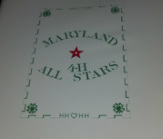The History of All Stars
Condensed From the History of the Maryland 4-H Club All Stars
In 1914 the United States Government established an Extension Service in each State and provided for work with rural youth. Those early clubs were known by names such as Boys' corn Clubs, Girls' Sewing Clubs, etc It was 1921 or 1922 before the term 4-H Clubs became more commonly used. It was decided that club work should be the development of knowledge, attitudes, skill and health. The 4 H's came to represent head, heart, hands and health. William Kendrick, the State Club Leader in West Virginia began building his program on the "four-fold life" basis that he experienced at the National Sunday School Summer Conference in Wisconsin. From Wisconsin, he brought the Indian Tribal tradition with its Council Circle, Indian names, Vigils, the Vesper Service, candle service and the Honor group. He suggested a group of youth fitting his vision organize a small group which became the first All Star Chapter - The Alpha Chapter in 1919.
In 1921 a group of West Virgina All Stars were invited to come to Maryland Club Week. The second, Beta chapter. of All Stars was formed. The original idea in these two states was that each year the chapter would select a few young men and women, active in 4-H Leadership, sterling personal character, high ideals, and unselfish service for membership in the All Star organization. Very few members were chosen annually in the early years and those chosen were not told until they were taken by the hand and led into the Circle in the presence of the entire Club Week group at the Consecration Service.
The Maryland Chapter owes much of its philosophy to Mr. E.G. Jenkins, known as "Jenks," "Daddy Jenks," or "Leni" and to Miss. Dorothy Emerson, known as "Dot," "Big Sis," and "Tonga." Daddy Jenks was a personal friend of "Teepi" and received his Indian name, "Leni Lenape" from "Teepi".
In 1914 the United States Government established an Extension Service in each State and provided for work with rural youth. Those early clubs were known by names such as Boys' corn Clubs, Girls' Sewing Clubs, etc It was 1921 or 1922 before the term 4-H Clubs became more commonly used. It was decided that club work should be the development of knowledge, attitudes, skill and health. The 4 H's came to represent head, heart, hands and health. William Kendrick, the State Club Leader in West Virginia began building his program on the "four-fold life" basis that he experienced at the National Sunday School Summer Conference in Wisconsin. From Wisconsin, he brought the Indian Tribal tradition with its Council Circle, Indian names, Vigils, the Vesper Service, candle service and the Honor group. He suggested a group of youth fitting his vision organize a small group which became the first All Star Chapter - The Alpha Chapter in 1919.
In 1921 a group of West Virgina All Stars were invited to come to Maryland Club Week. The second, Beta chapter. of All Stars was formed. The original idea in these two states was that each year the chapter would select a few young men and women, active in 4-H Leadership, sterling personal character, high ideals, and unselfish service for membership in the All Star organization. Very few members were chosen annually in the early years and those chosen were not told until they were taken by the hand and led into the Circle in the presence of the entire Club Week group at the Consecration Service.
The Maryland Chapter owes much of its philosophy to Mr. E.G. Jenkins, known as "Jenks," "Daddy Jenks," or "Leni" and to Miss. Dorothy Emerson, known as "Dot," "Big Sis," and "Tonga." Daddy Jenks was a personal friend of "Teepi" and received his Indian name, "Leni Lenape" from "Teepi".

complete History of the Maryland 4-H All Stars is available by purchase at semi-annual and annual conferences or by contacting the Historian. Updates are published annually.
History Forward
History Chapter 1
History Chapter 2
History Chapter 3
History Chapter 4
History Chapter 5
History Chapter 6
History Chapter 7
All Stars Inducted 1949-1993
Updates 1949-1959
Updates 1960-1969
Updates 1970-1979
Updates 1980-1989
Updates 1990-1999
Updates 2000-2009
Updates 2010-2012
Updates 2012-2013
Updates 2013-2014
Updates 2014-2015
Updates 2015-2016
Updates 2016-2017
Updates 2017-2018

